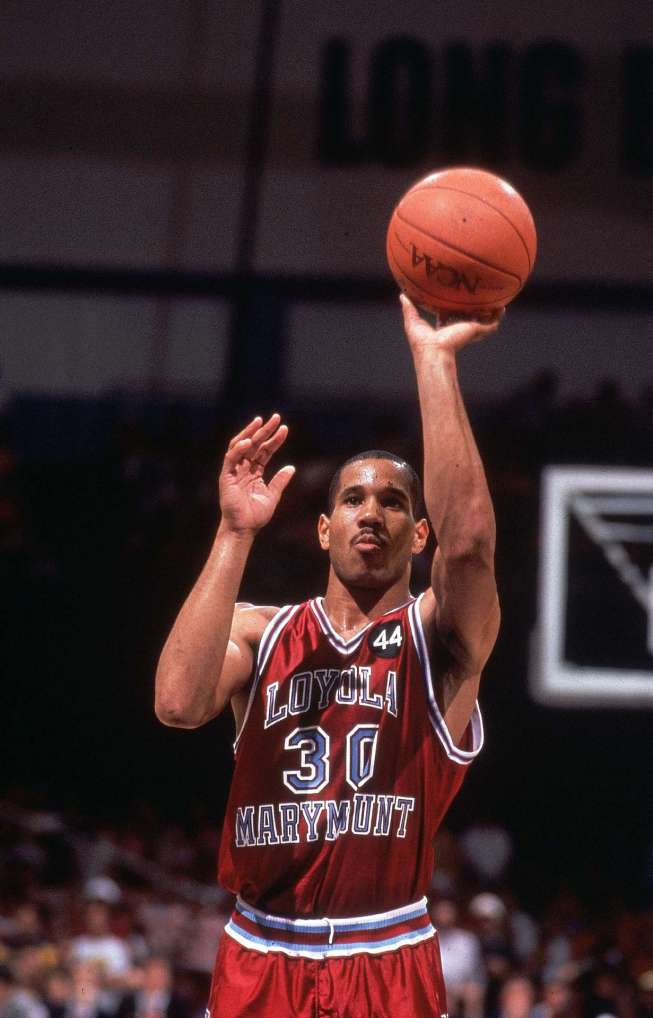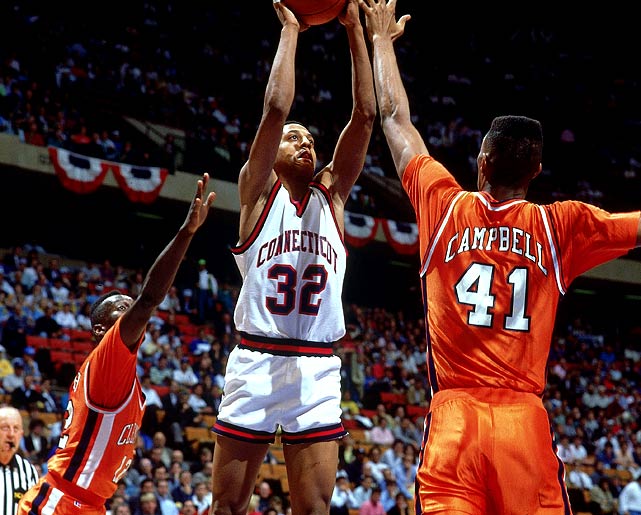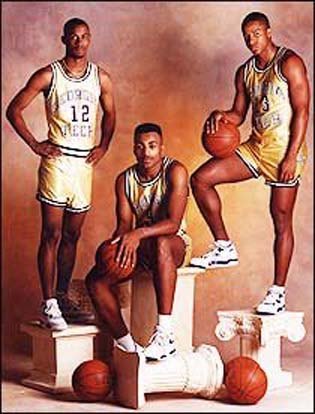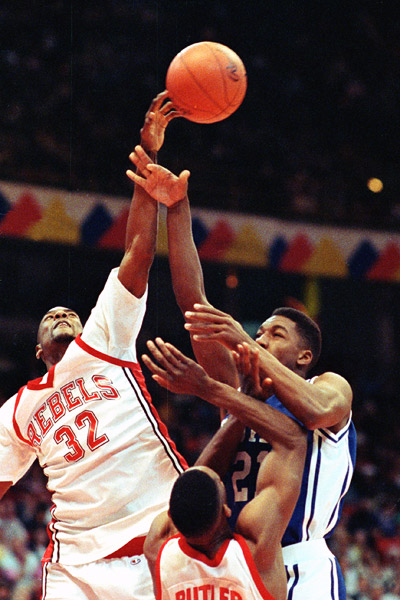 General
General  General Archive
General Archive  The Best Tournament Ever
The Best Tournament Ever
Sadly, we live in a degraded age of college basketball. The first weekend of the 2013 NCAA Tournament has been proof enough, with arenas around the country reverberating with the harsh sound of shots banging off backboards and clanging off rims. It’s been competitive but it’s also been ugly. When a 13th seed (LaSalle) can make three field goals and shoot under 20 percent in the second half and still win a game, you know it’s ugly.
reverberating with the harsh sound of shots banging off backboards and clanging off rims. It’s been competitive but it’s also been ugly. When a 13th seed (LaSalle) can make three field goals and shoot under 20 percent in the second half and still win a game, you know it’s ugly.
Things weren’t always this way. To find a different game, a better game, we need to go back a generation. The month was March; the year was 1990. Janet Jackson was dominating the pop charts with Rhythm Nation 1814; the number-one movie at the box office was The Hunt for Red October; “Roseanne” topped the Neilson ratings.
Meanwhile, the 1990 NCAA Tournament was the showcase for a golden era of college basketball. Round after round spectators were treated to thrilling games with fantastic finishes. And the games weren’t just close- they were also well played, particularly on offense. Players handled, moved and shot with great skill in games where the scores routinely cracked the 90-point barrier.
It was college basketball played at the highest level. The field was breathtakingly deep, with even middle-seeded teams boasting multiple future NBA players. The coaches were legendary. The storylines were enduring. And the action was end-to-end, from the first minute to the fortieth and beyond.
Let’s take a look back at 1990 and why this was the greatest NCAA Tournament ever played.
Buzzer-Beaters: The buzzer-beating shot is a staple of the March Madness highlight films, and there were enough in 1990 to fill an entire reel. No fewer than nine games featured shots that either tied or won games in the last five seconds:
- In the first round, Ohio State’s Alex Davis drilled a three-pointer with three seconds left in regulation to tie Providence in a game the Buckeyes went on to win in overtime, 84-83.
- Also in the first round, Northern Iowa’s Maurice Newby hit a three-pointer just before the horn to stun heavily favored Missouri, 74-71.
- Also in the first round, Murray State’s Greg Coble nailed a three-pointer at the buzzer to force overtime between the 16th-seeded Racers and top-seeded Michigan State. Sparty went on to win in the extra session, 75-71.
- Still in the first round, Ball State’s Parris McCurdy hit a turnaround jumper while being fouled and knocked in the game-winning free throw with zeros on the clock to take out Gary Payton and Oregon State, 54-53.
- Moving to round two, North Carolina’s Rick Fox eliminated top-ranked Oklahoma with a baseline drive at the one-second mark.
- On the same day in the same arena (the Frank Erwin Center in Austin) Arkansas’s Todd Day followed his own miss to beat underdog Dayton with three seconds left.
- In the Sweet 16, with UConn trailing Clemson 70-69 and one second remaining, Scott Burrell threw a length-of-the-court pass to Tate George, who hit a turnaround jumper at the horn to give the Huskies the victory.
- The next night, still in the Sweet 16, Georgia Tech’s sensational freshman Kenny Anderson hit a long jumper to tie Michigan State at the buzzer. (To be technical, the shot came after the buzzer but the officials counted it anyway.) Tech wound up winning in overtime, 81-80.
- In the Elite 8, Duke’s Christian Laettner hit a leaning jumper to beat UConn at the buzzer (a shot that is overshadowed by the one Laettner hit two years later against Kentucky.)
In addition, two second-round games were won on the free-throw line in the last ten seconds. UCLA freshman Tracy Murray sank a pair to beat Kansas 71-70, while two freebies by Texas’s Travis Mays gave the Longhorns a 73-72 upset of Purdue.
 Great Games: In addition to the buzzer-beaters, the 1990 Tournament was thick with outstanding games that came down to the final shot. More than one-third of the games- 24 out of 63- were decided by either three points or less, or in overtime. A sampling of these delicacies include:
Great Games: In addition to the buzzer-beaters, the 1990 Tournament was thick with outstanding games that came down to the final shot. More than one-third of the games- 24 out of 63- were decided by either three points or less, or in overtime. A sampling of these delicacies include:
- Georgia Tech’s sensational 94-91 second-round victory over LSU, in which the Yellow Jackets bombed their way back from a 24-5 first-half deficit. Four future NBA lottery picks played in this second-round game, which tells you something about just how deep the field was.
- Tech’s 93-91 Southeast Regional Final win over Minnesota, another up-and-down thriller that wasn’t decided until Gopher Kevin Lynch missed a three at the buzzer.
- Syracuse’s 63-61 second-round win over Virginia in front of a Cavalier-friendly crowd in Richmond; a game that ended with the normally unflappable Terry Holland (coaching his final game) up in arms after Bryant Stith got contact but no call on his failed last-second shot.
- UNLV’s 69-67 Sweet 16 win over upstart Ball State, a white-knuckler that wasn’t decided until Stacey Augmon stole Mike Spicer’s lob pass in the final seconds.
- Arkansas’s 88-85 Midwest Regional Final win over archrival Texas (fellow members of the old Southwest Conference) that saw the Longhorns fall just short of overtime when Travis Mays couldn’t knock down a three-point attempt at the buzzer.
Great Coaches, Great Players: In terms of the talent both on the floor and on the bench, 1990 may have featured the deepest field in Tournament history. Sixteen of the participating head coaches either had won or would win at least one National Championship in their careers, a group that included iconic figures like Bobby Knight, Dean Smith, John Thompson, Denny Crum and Jerry Tarkanian.
And then there were the players, including future NBA notables Larry Johnson, Jimmy Jackson, Gary Payton, Robert Horry, Elden Campbell, Dale Davis, Christian Laettner, Rick Fox, Kendall Gill, Tyrone Hill, Alonzo Mourning, Dikembe Mutumbo, Steve Smith, Kenny Anderson, Dennis Scott, Shaquille O’Neal and Derrick Coleman- among others. That’s a lot of big-time talent packed into one Tournament.
The strength of the field is revealed in the rosters of teams that weren’t among the top sixteen seeds. LSU, fifth seed in the Southeast, had Shaq, Chris Jackson and Stanley Roberts. Clemson, fifth seed in the East, had Elden Campbell and Dale Davis on its front line. Alabama, seventh seed in the West, had Horry, David Benoit and Keith Askins. North Carolina, eight seed in the Midwest, featured Fox, George Lynch, Hubert Davis and Scott Williams.
Great Offense: Remember the scene in Hoosiers when Norman Dale enters Hickory’s gym to meet the team for the first time and would-be coach George is already in there exhorting the Huskers to shoot more? “You can’t score if you can’t shoot… shoot from outside!” Back in the day, college basketball was filled with George’s… and the score sheets were filled to the brim.
These days, college basketball is Norman Dale’s game. The nation’s highest scoring team in 2012-13 was Northwestern State. The Demons averaged an even 81 points per game on their way to the Southland Conference Championship. Appropriately enough for this Tournament, they then scored 15 second-half points in their Round-of-64 loss to Florida.
NWSU’s points-per-game average would have ranked 49th in 1989-90. It was a time of racehorse basketball, with teams sprinting up and down the court and mad bombers like Dennis Scott and UNLV’s Anderson Hunt routinely jacking up 23-footers off three-on-one breaks. Loyola Marymount and Oklahoma each averaged more than 100 points per game, with Loyola’s dizzying 122.4 a major-college record that still stands.
bombers like Dennis Scott and UNLV’s Anderson Hunt routinely jacking up 23-footers off three-on-one breaks. Loyola Marymount and Oklahoma each averaged more than 100 points per game, with Loyola’s dizzying 122.4 a major-college record that still stands.
The way the game was played in 1990 was symbolized by LSU’s epic 148-141 overtime victory over Loyola that February. So furious was the action that during the first half the electric typewriter that recorded the scoring seized up and had to be replaced. It was that kind of game back then.
The running and gunning carried over into the postseason. Sixteen teams broke the 90-point mark in the 1990 Tournament; nine went over a hundred. By contrast, just two teams in the 2012 Tourney scored 90 or more (and in the same game at that; Kentucky’s 102-90 South Regional Final win over Baylor.) The explosive teams prospered: four of the eight regional finalists (Loyola, UNLV, Arkansas and Texas) finished in the top ten nationally in scoring offense.
Round after round the Tournament sky lit up with offensive fireworks. Tenth-seeded Texas ran up 60 second-half points in its 100-88 first-round win over Georgia and added 61 in the second half of its 102-89 Sweet 16 win over Xavier. Loyola Marymount shattered the single-game scoring record with 149 points in its second-round upset of Michigan. Two rounds later UNLV racked up the second-highest total ever with 131 in its win over LMU. The Rebels then became the only team to score more than 100 points in the title game in their victory over Duke.
Sure, there’s a place for a grinding defensive struggle. Duke’s 61-59 title-game win over Butler in 2010 was a tremendous game, if an inartistic one. But it was just plain fun to watch teams of the lost era pile up the points with computer-like speed. We’ll probably never see the likes of them again- unfortunately.
Iconic Groups: College basketball circa 1990 was not the transient sport it is today. There were no one-and-done players or one-and-done teams like John Calipari’s Kentucky outfits. Even the best players generally stayed in school at least three years, with a few exceptions (notably Kenny Anderson, who declared for the draft as a true sophomore.) Three of the five first-team All-Americans for 1990 (Gary Payton, Lionel Simmons and Derrick Coleman) were seniors, as opposed to one in 2012 (Draymond Green.)
All of this meant the players were more familiar to fans, and teams had well-defined identities. After watching these guys for three or four years, fans got to know them.
The lineup of 1990 Tournament teams was splashed with iconic nicknames, not for individual players but for groups of players. Texas had the BMW Ultimate Scoring Machine (future Cavaliers assistant GM Lance Blanks, Travis Mays and Joey Wright.) Clemson had the Duo of Doom (forwards Elden Campbell and Dale Davis.) Arkansas had May-Day (Lee Mayberry and Todd Day.) And Georgia Tech had Lethal Weapon 3 (Dennis Scott, Brian Oliver and Kenny Anderson.)
I can’t think of similar nicknames in today’s game. Can you? Most of the great players don’t stick around long enough to earn a nickname.
Loyola Marymount: There has never been a team quite like Paul Westhead’s LMU Lions before or since their tragic, dramatic run to the 1990 Elite 8. No team entered the Tournament with heavier hearts after the death of Hank Gathers from heart failure in a West Coast Conference tourney game. The charismatic Gathers, who had led the nation in scoring and rebounding the previous year (only three have accomplished that feat, the others being Xavier McDaniel and Kurt Thomas,) haunted that March like a ghost.
It’s a shame. Obviously because of the human element- the loss of a human life, and everything affected by that loss- but also because Loyola Marymount was a fascinating team when free of tragedy. Nobody played the game like they did. Other teams ran but not with the shamelessness of the Lions, who would actually let opponents score just to get numbers on the other end, get a quick score of their own and fuel the pace that was unsustainable to almost everyone but them.
What LMU did that March, without Gathers, was stunning- particularly in the second round against Michigan, which had won the title the previous year and had Rumeal Robinson, Loy Vaught, Terry Mills and Sean Higgins back from that team. Loyola hung 84 second-half points on the Wolverines, hit 21-of-40 from three-point range (including 11-of-15 by sweet-shooting surfer boy Jeff Fryar) and forced 27 turnovers in the 149-115 rout that left Michigan and the national television audience gasping for breath.
Loyola’s unique style, the tragedy of Gathers’s death, Bo Kimble shooting free throws left-handed in honor of his longtime teammate- it all made for a story unlike any in Tournament history. And it lasted all the way to the Round of 8, when the Lions met their destiny at the hands of the true Team of the Tournament- UNLV.
 UNLV: In some ways Jerry Tarkanian’s UNLV Runnin’ Rebels were college basketball’s answer to the Miami Hurricanes of that same era in college football. Both programs were based in glamour cities with a pronounced sleazy side. Both were seen as renegade programs to an extent- particularly UNLV, where Tarkanian had been playing chicken with the NCAA for almost two decades. Both carried themselves with a swagger that elicited either love or hate, depending on the eye of the beholder.
UNLV: In some ways Jerry Tarkanian’s UNLV Runnin’ Rebels were college basketball’s answer to the Miami Hurricanes of that same era in college football. Both programs were based in glamour cities with a pronounced sleazy side. Both were seen as renegade programs to an extent- particularly UNLV, where Tarkanian had been playing chicken with the NCAA for almost two decades. Both carried themselves with a swagger that elicited either love or hate, depending on the eye of the beholder.
And like Miami, Vegas possessed just as much substance as style. Though they played above the rim and directed an endless stream of trash-talk at opponents, they were also as unselfish, team-oriented and hard working as any old-school purist could hope for. They were gamers with game.
The names from that team are hallowed. There was Greg Anthony, the tough, cerebral point guard with moves as sweet as his flattop hairdo. There was Anderson Hunt, the scoring machine that had the green light from anywhere in the building. There was Stacey Augmon, the Plastic Man, defensive stopper and finisher on the break extraordinaire. And finally there was broad-shouldered Larry Johnson, the junior-college transfer that galvanized the Rebels with his all-around game and outsized personality.
These men proved their worth and then some in the Tournament. Only one of their wins- their 69-67 Sweet 16 squeaker over rugged Ball State- was in doubt in the final seconds. Four of their wins came by double digits, including three 30-point blowouts. The Rebels brought a crushing end to Loyola Marymount’s Cinderella story with a 131-101 rout in the West Regional Final. And they climaxed their run for the ages with the biggest wipeout in Championship Game history- the 103-73 domination of Duke.
You’d think that the one-sided title game would be an argument against 1990 being the Greatest Tournament Ever. Not true. Far from being a dreary romp, the Duke game was a jaw-dropping validation of UNLV’s greatness. Every quality that made the Rebels great- talent, athleticism, relentlessness and team chemistry- was on display against a good Blue Devils team that was simply in over its head. UNLV was magnificent that night, breaking it open in the second half with an 18-0 run that took less than three minutes and left an indelible impression on all who witnessed it.
After it was over Mike Krzyzewski, gracious in abject defeat, said of the Rebels, “I am in awe of what they did tonight.” The same could have been by viewers of the entire Tournament. We’ll see more great players, great games and great finishes- but in terms of the quality of games, the quality of the players and the quality of the storylines, we’ll never see another NCAA Tournament like 1990.
- NBA Announces 2013-2014 Schedule
- Browns Ink Sharknado
- Sharknado A No-Show For Rookie Camp
- Trent Richardson Out Until Training Camp
- Browns Sign Brandon Jackson
- Carrasco Suspended Eight Games
- Browns Add to Wide Receiver Depth with David Nelson
- Browns Need to Learn from Past Draft Mistakes
- Browns Release Chris Gocong and Usama Young
- Browns Missing on Grimes Disappointing, But Not The End
The TCF Forums
- Official- Browns Coach Search/Rumors
Hikohadon (Tuesday, January 21 2014 1:24 PM) - Movies coming out
rebelwithoutaclue (Tuesday, January 21 2014 12:56 PM) - 2015 Recruiting
jclvd_23 (Tuesday, January 21 2014 12:38 PM) - The 2014 Offseason Thread
Larvell Blanks (Tuesday, January 21 2014 12:25 PM) - Chris Grant's first 3 drafts
Kingpin74 (Tuesday, January 21 2014 10:13 AM) - Mike Brown
YahooFanChicago (Monday, January 20 2014 11:15 PM) - 2014 Hoops Hockey Hijinx
jpd1224 (Monday, January 20 2014 4:44 PM) - 2014 Recruiting
jclvd_23 (Monday, January 20 2014 2:26 PM) - Wish List - #4 Pick
Hikohadon (Monday, January 20 2014 1:26 PM) - #1 overall pick Anthony Bennett
TouchEmAllTime (Sunday, January 19 2014 1:28 PM)



